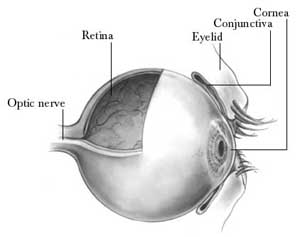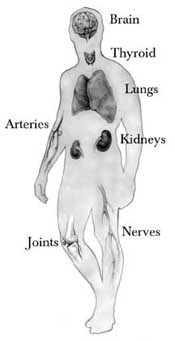The Eye in Systemic Disease
Systemic diseases are diseases that involve many organs or the whole body. Many of these diseases also affect the eyes. In fact, an eye exam sometimes leads to the first diagnosis of a systemic disease.
Why is the eye so important in systemic disease?
The eye is composed of many different types of tissue. This unique feature makes the eye susceptible to a wide variety of diseases as well as provides insights into many body systems. Almost any part of the eye can give important clues to the diagnosis of systemic diseases. Signs of a systemic disease may be evident on the outer surface of the eye (eyelids, conjunctiva and cornea), middle of the eye and at the back of the eye (retina).

The optic nerve and eye movements often reflect changes in the central nervous system. This is because a large part of the brain helps provide visual information and controls eye movements. Because the eye structures are uniquely transparent, a doctor can see inside the eye. The eye is the only organ in the body in which a doctor can directly see blood vessels. The health of the blood vessels in the eye often indicates the condition of the blood vessels (arteries and veins) throughout the body.
Which systemic diseases most commonly affect the eye?
The eye may be involved in these diseases, among others:

- Diabetes mellitus – an imbalance in blood glucose (sugar) levels.
- Acquired immunodeficiency syndrome (AIDS) – a life-threatening disease caused by a virus that cripples the body’s immune defenses.
- Graves’ disease – a thyroid disorder, most often in women, which can cause a goiter (swelling in the front part of the neck) and protruding eyes.
- Sarcoidosis – a disease that mainly affects the lungs, brain, joints and eyes, found most often in young African-American women.
- Systemic lupus erythematosus – a connective tissue disorder involving mainly the skin, joints and kidneys.
- Rheumatoid Arthritis
- Hypertension (high blood pressure)
- Atherosclerosis (hardening of the arteries)
- Sickle cell disease – an inherited blood disorder that can block circulation throughout the body, primarily affectingAfrican-Americans
- Multiple sclerosis – a disease that damages nerve coverings, causing weakness, coordination and speech disturbances.
How do systemic diseases affect the eye?
Various systemic diseases affect the eye differently.
Diabetes can cause severe eye complications, including swelling of the retina (macular edema), abnormal growth of new retinal blood vessels and bleeding inside the eye. Changes in the blood vessels of the retina or fluctuations in vision sometimes lead to the first diagnosis of diabet4s. Diabetic retinal disease is a leading cause of blindness in this country. (For more information on "Diabetic Retinopathy", see February/March 1988 Eye Facts.) In addition, people with diabetes develop cataracts earlier than other people. Therefore, it is important for them to have regular eye exams.
AIDS can cause infections in the eye, retinal detachment, eyelid tumors and neuro-ophthalmic disorders. AIDS-related infections can often lead to blindness, but effective eye treatment is now available. Abnormal retinal circulation is another frequent complication of AIDS. Sometimes, the first signs of AIDS are abnormalities in the retina. (See March/April 1991 Eye Facts on "AIDS and the Eye" for more information.)
Graves’ disease can cause protruding eyes (proptosis), limitations of eye movement, double vision and corneal disease. Severe cases may have damage to the optic nerve. Sometimes the eye symptoms in Graves’ disease can appear before other symptoms and signs.

The eye is prone to inflammation. A type of inflammation called uveitis is the most common eye problem caused by sarcoidosis. Uveitis can result in painful and red eyes, blurred vision and glaucoma. Scleritis, an inflammation of the white part of the eye, can result from systemic lupus erythematosus and rheumatoid arthritis. Both of these conditions also can cause dry eyes. High blood pressure and atherosclerosis can damage the retinal blood vessels. Usually, this damage does not result in any visual symptoms at first. However, it can eventually lead to more severe complications in the retina as well as in the body. In persons with high blood pressure, the extent of damage in the eye can directly relate to damage that occurs in the kidneys. High blood pressure can be first diagnosed when changes in the blood vessels of the eye are found.
Sickle cell disease also can cause abnormal retinal vessels as well as bleeding inside the retina. Sickle cell eye disease can sometimes lead to blindness if not treated with laser therapy.
Multiple sclerosis can cause eye movement problems as well as optic nerve disease causing loss of vision. Neurologic diseases such as multiple sclerosis may be first suspected when an eye doctor finds changes in eye movement, vision or the function of the optic nerve.
Cancer can start in the eye or can spread to the eye. Tumors of the eye are rare, however. Depending on its location, an eye tumor may or may not distort vision at an early stage. Early detection and treatment of cancer in the eye can be vision-saving and, in some cases, life-saving. Brain tumors also may affect vision by causing swelling of the optic nerve. Occasionally, a doctor may first suspect a brain tumor after finding optic nerve swelling on an eye exam.
Diseases other than those mentioned above also can affect the eye.
What about treatment?
For any of the eye problems mentioned above, it is important to have an examination by an ophthalmologist, who will confer with your primary care physician. The ophthalmologist, working with other health care specialists and your family physician, often plays an important role in treating systemic diseases. Depending on the condition, systemic treatment may be needed. Ophthalmic treatment can range from drugs for inflammatory diseases (e.g., uveitis) to laser therapy for retinal vascular diseases (e.g., diabetic retinopathy) to surgery for tumors.
